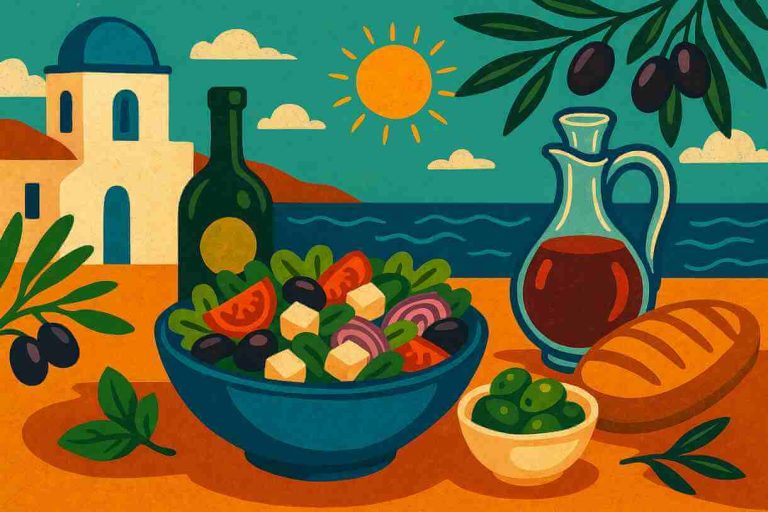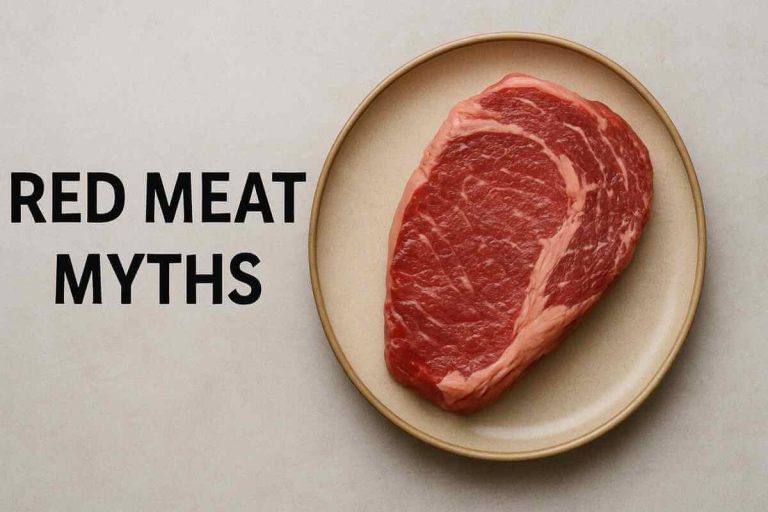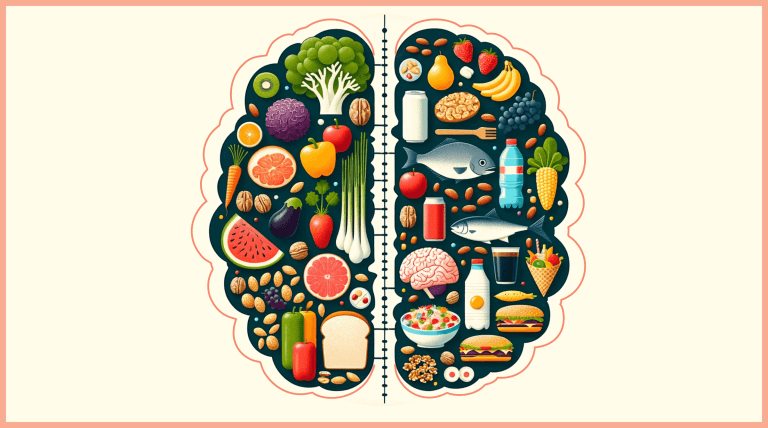The Mediterranean Diet has a way of showing up in nearly every conversation about healthy eating. For decades, it’s been hailed as the gold standard, celebrated by doctors, nutritionists, and now endlessly promoted across magazines and social media feeds. Fresh fruit, colorful salads, glugs of olive oil, washed down with a glass of red wine. What’s not to like?
To really judge how healthy the Mediterranean Diet is, we need to ask: does it genuinely work in harmony with our body’s systems, or does it just look impressive when compared to the deep-fried, sugar-loaded chaos of the Standard American Diet? And if much of its reputation comes from looking “better than bad,” then what parts of the Mediterranean approach are truly essential for health—and which parts might actually be holding us back?
The truth is, the Mediterranean approach definitely has merits—it’s based on real, whole foods rather than ultra-processed junk. But it also comes with a few caveats. Many of the early studies behind it were built on outdated nutritional science, like the idea that saturated fats (think steak or butter) were a heart attack waiting to happen. We now know that’s not strictly true. And while the diet is often praised for being “balanced,” it can still be quite high in carbohydrates, which doesn’t do our modern epidemic of insulin resistance any favors.
So, is the Mediterranean Diet healthy? It certainly can be, especially when compared to highly processed alternatives. But is it the ultimate diet, and one you should follow for life? That’s where the conversation gets interesting.
What is the Mediterranean Diet?
When people talk about the “Mediterranean Diet,” they’re not really referring to one single, uniform way of eating like carnivore, keto, or vegan diets. Instead, it refers to a broad pattern of foods inspired by the traditional diets of countries bordering the Mediterranean Sea—places like Greece, Italy, and Spain in the mid-20th century.
As such, one person’s Mediterranean Diet might look very different from another’s—so much so that you might not even recognize them as following the same “diet.” A Greek fisherman eating grilled sardines with olives and flatbread is technically on the same diet as an Italian farmer enjoying pasta with tomato sauce and a splash of olive oil.
What ties these eating patterns together, however, is a shared foundation: The Mediterranean diet places an emphasis on whole, minimally processed foods, lots of vegetables, olive oil as a primary fat, and relatively little red meat.
The Mediterranean Diet centers around fresh, whole foods with olive oil as the primary fat, alongside nuts, seeds, fish, poultry, legumes, and moderate amounts of dairy like yogurt and cheese. Plates are filled with colorful fruits and vegetables—tomatoes, leafy greens, citrus, figs, olives—balanced with whole grains such as bread, pasta, and rice, all flavored with herbs like oregano, parsley, and rosemary. Water, herbal teas, and even a glass of red wine with meals are common, while red meat, processed foods, refined grains, and added sugars are kept to a minimum.
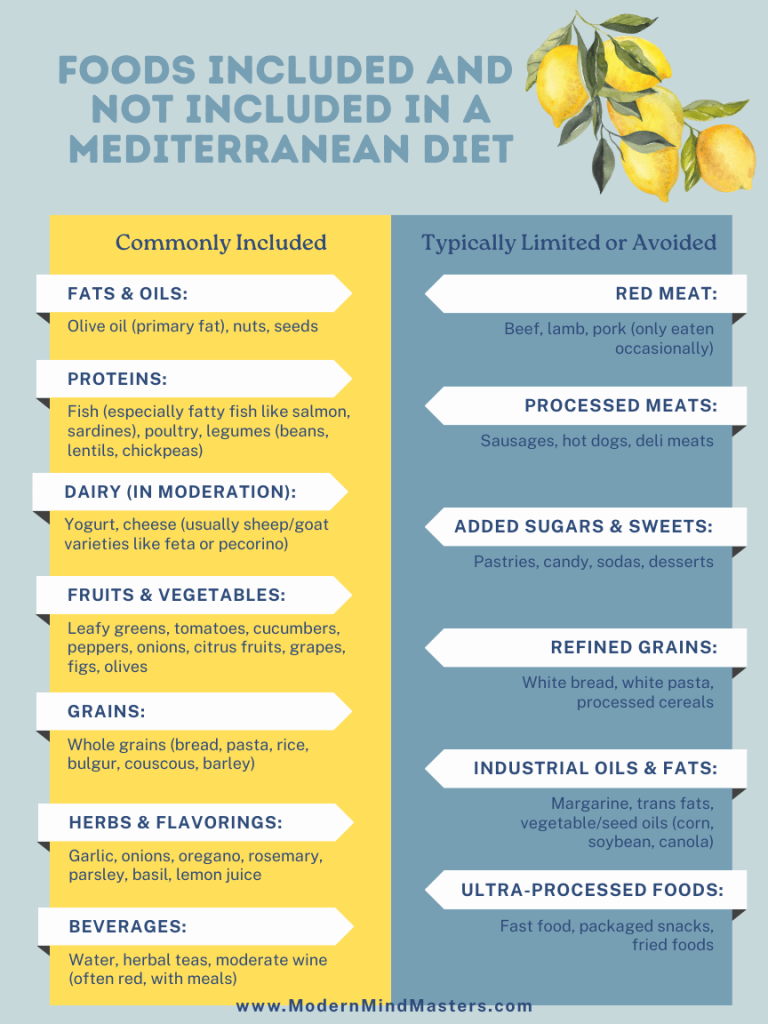
Why the Mediterranean Diet Was Seen as Healthy
The Mediterranean Diet didn’t start as a modern wellness trend—it grew out of epidemiological studies in the mid-20th century, most famously the Seven Countries Study led by American physiologist Ancel Keys. Keys noticed that people living in southern Italy, Greece, and other parts of the Mediterranean appeared to have lower rates of heart disease compared to those in Northern Europe and the United States. His work suggested that their diet—rich in olive oil, vegetables, legumes, and fish, but relatively low in red meat and butter—was the key factor.
The findings made headlines and shaped decades of nutrition advice. The Mediterranean Diet was soon championed by doctors, public health authorities, and eventually lifestyle magazines as the “heart-healthy” diet. Its emphasis on olive oil, whole grains, and plant-based eating fit neatly into the dominant nutrition narrative of the time: that saturated fat was dangerous and should be minimized.
Over time, what began as regional eating habits became codified into a global health prescription, reinforced by international organizations like the World Health Organization and the American Heart Association. From there, it entered mainstream culture—not just as a dietary recommendation, but as an idealized lifestyle centered on “eating like the Greeks.”
But as it always does, time would soon tell the true story. We now know that Keys originally collected data from 22 countries, but only published results from seven—those that conveniently supported his hypothesis that saturated fat intake correlated with heart disease. Countries that didn’t fit the narrative, like France (with high saturated fat consumption yet low heart disease), were excluded. This selective reporting gave the Mediterranean Diet a powerful early boost, but also built its reputation on shaky foundations.
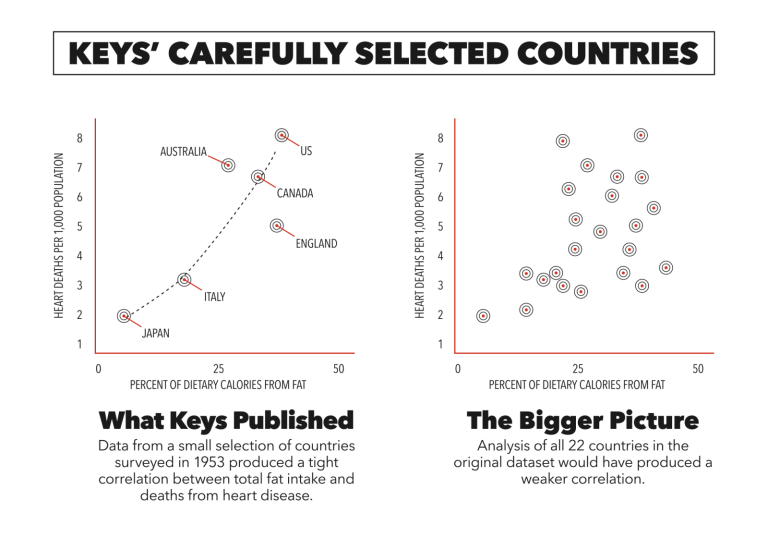
Later studies reinforced the idea that Mediterranean-style eating was “heart-healthy,” but these, too, were mostly stacked against the Western diet—by then dominated by sugar, refined flour, seed oils, and ultra-processed foods.
Unsurprisingly, a way of eating built on fresh vegetables, olive oil, and fish came out on top. It’s a bit like saying water is healthier than soda, or that a brisk walk is safer than juggling chainsaws—the comparison was so lopsided that the Mediterranean Diet couldn’t help but look like the hero.
The Flaws in the Mediterranean Narrative
While any diet focusing on healthy, whole foods, including the Mediterranean diet, is vastly better than the now common SAD diet, the Mediterranean narrative misses the mark in a few key areas that prevent it from being optimum.
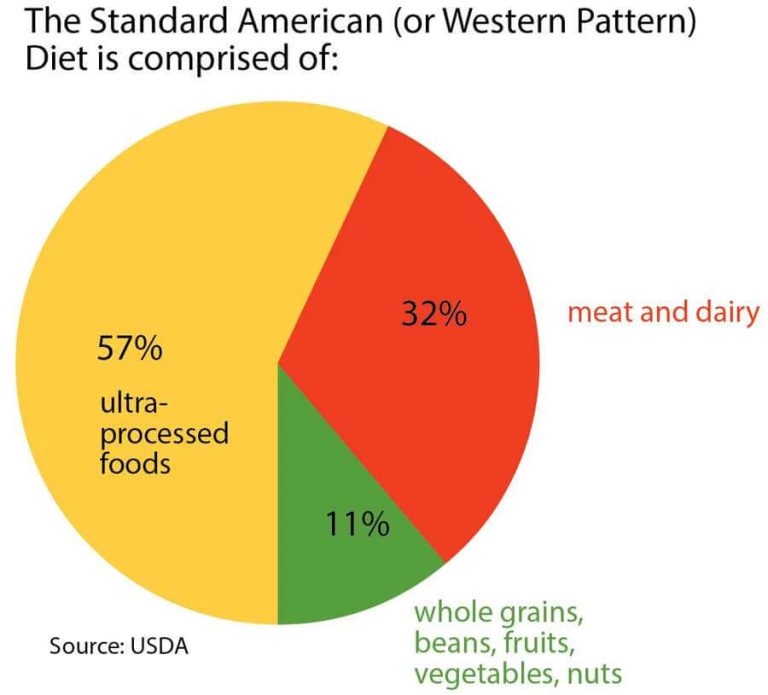
Saturated Fat Myth
One of the key weaknesses in the Mediterranean Diet, as it’s promoted today, is its avoidance of saturated fat. This guidance was rooted in the diet–heart hypothesis from the 1950s, which claimed saturated fat raises cholesterol, and cholesterol causes heart disease. But decades of research now show this story doesn’t hold up.
For example, a 2010 meta-analysis of 21 studies involving over 340,000 participants published in the American Journal of Clinical Nutrition found “no significant evidence for concluding that dietary saturated fat is associated with an increased risk of heart disease or stroke.” In 2014, another meta-analysis of 72 studies published in the Annals of Internal Medicine reached the same conclusion: saturated fat intake was not linked to heart disease. And in 2020, the Journal of the American College of Cardiology stated outright: “There is no robust evidence that limiting saturated fat reduces cardiovascular risk.”
Biology also backs this up. Saturated fat is not some foreign invader; it’s built into your body. Every cell membrane you have is stabilized by saturated fat. Your liver actively converts excess carbohydrates into saturated fat for long-term energy storage. And human breast milk — the most natural food designed for growth — is nearly 50% saturated fat, fueling brain development and immune health. If saturated fat were inherently harmful, it would make little sense for nature to hardwire it into our biology at every stage of life.
By discouraging red meat, dairy, eggs, and other nutrient-dense whole foods, the Mediterranean Diet ends up excluding some of the richest sources of fat-soluble vitamins (A, D, E, K), minerals like iron and zinc, and complete proteins. The irony is that while the diet looks good compared to processed, sugar-heavy alternatives, its fear of saturated fat keeps it from being truly optimal.

Carbohydrate Levels
Another limitation of the Mediterranean Diet is that it often leans heavily on carbohydrates—bread, pasta, rice, and legumes form the backbone of many Mediterranean plates. While these foods are unrefined and certainly better than ultra-processed carbs, the issue isn’t simply quality—it’s quantity.
Modern research shows that excess carbohydrate intake is one of the biggest drivers of insulin resistance, the root of metabolic disorders like obesity, type 2 diabetes, and fatty liver disease. In fact, up to 93% of Americans show signs of poor metabolic health, largely due to chronically elevated blood sugar and insulin levels. A diet that still prioritizes bread and pasta—even if “whole grain”—risks perpetuating the very problems it’s supposed to prevent.
Compare this to low-carb approaches like keto, which cap carbs at under 50 grams per day. In this state, the body switches from running on glucose to burning fat and producing ketones—a metabolic state that has been shown to improve blood sugar control, enhance fat burning, and even provide the brain with a cleaner, more efficient fuel source. Studies confirm that ketosis can reverse insulin resistance and improve markers of metabolic health far more effectively than diets that remain high in carbs, even when those carbs come from “healthy” sources.
This doesn’t mean the Mediterranean Diet is bad—it’s certainly healthier than the Standard American Diet—but its higher carbohydrate load means it doesn’t always address the single most pressing modern health issue: metabolic dysfunction. For individuals already dealing with insulin resistance or prediabetes, a carb-heavy Mediterranean approach may not be optimal, no matter how much olive oil you drizzle on top.

Overgeneralization
Another flaw in the way the Mediterranean Diet is presented today is that it’s treated as if there’s only one version of it. In reality, there’s no single “Mediterranean Diet.” A fisherman in Crete, a farmer in southern Spain, and a family in coastal France all ate very different foods depending on geography, culture, and tradition. Yet modern nutrition writers often package these diverse traditions into one tidy set of rules: plenty of olive oil, lots of vegetables, whole grains, fish, nuts, and very little red meat.
The truth is that the modern “Mediterranean Diet” is less a faithful representation of how people across the region actually ate, and more a Western reconstruction based on mid-20th-century nutrition beliefs. Influenced heavily by Ancel Keys’ work, it was curated to fit the dietary guidelines of the time: avoid saturated fat, eat grains liberally, and focus on plant foods. What gets marketed as the Mediterranean Diet today is essentially a cherry-picked, idealized snapshot and not a genuine reflection of the wide variety of diets Mediterranean populations enjoyed.
And finally, the supposed health benefits of the Mediterranean Diet have been overgeneralized as well. Early studies credited diet alone for lower rates of heart disease in Mediterranean regions, but lifestyle factors like daily walking, manual labor, community eating, abundant sunshine (which has a tremendous effect on Vitamin D levels), and lower stress levels also played huge roles. To suggest that olive oil and pasta alone explain better health is to ignore the much bigger picture. It’s a bit like saying all Europeans eat fish and chips—technically true for some, but wildly misleading if you try to apply it to everyone.
What Actually Makes the Mediterranean Diet Healthy
With all the flaws and overhype surrounding the Mediterranean Diet, it’s easy to forget that there are still plenty of reasons why it has been associated with good health outcomes. The real strengths of the diet don’t come from avoiding saturated fat or piling on the grains, but from its emphasis on whole, unprocessed foods and a lifestyle that encourages balance.
First, the Mediterranean Diet is naturally rich in fresh vegetables, herbs, and polyphenol-dense foods that fight inflammation and oxidative stress. This isn’t because broccoli or tomatoes are magic bullets, but because they replace the industrial seed oils, refined sugars, and processed snacks that dominate the Standard American Diet. Simply swapping processed food for real food goes a long way toward improving health.
Second, it includes a variety of natural fats—olive oil, nuts, and fatty fish—that provide stable energy, support heart health, and reduce inflammation. While the modern version of the diet downplays saturated fats, traditional Mediterranean eating still included whole dairy, cheese, and meat in moderation—all nutrient-dense foods that round out the diet when left intact.
Finally, the Mediterranean Diet promotes eating as a lifestyle, not just a checklist. Meals are often enjoyed slowly, with family or community, rather than rushed or eaten on the go. This social and mindful approach to eating helps regulate appetite, lowers stress, and encourages better digestion. Combined with naturally active lifestyles in many Mediterranean regions (walking, farming, manual work), this creates a health advantage far beyond the food itself.
In short, what makes the Mediterranean Diet healthy isn’t its low saturated fat or higher carb content; it’s the fact that it’s rooted in whole foods, healthy fats, and balanced eating patterns, all while steering clear of the ultra-processed junk that dominates modern diets.
A More Balanced Perspective
At the end of the day, the Mediterranean Diet shouldn’t be seen as a rigid list of what you can and can’t eat, but rather as a reminder of how powerful it is to simply return to whole, unprocessed foods. Whether you follow the Mediterranean model or not, just making the switch away from the carb-heavy, ultra-processed Standard American Diet will put you ahead of 80% of the population in terms of health.
If you want to take things further, there’s plenty of room to personalize. Incorporating nutrient-dense animal foods like red meat, eggs, and full-fat dairy can round out the nutrient profile that the modern Mediterranean Diet tends to avoid. Experimenting with carbohydrate reduction—whether through low-carb, keto, or cyclical approaches—can also help you discover how your own body responds and whether you feel more energized, leaner, or metabolically healthier.
But if you’re looking for bang for your buck—the biggest health gains for the smallest commitment—start with the basics: whole foods, real ingredients, and meals made from scratch instead of boxes and bags. In that sense, the Mediterranean Diet is valuable not because it’s perfect, but because it helps people rediscover food in its most natural form. Whether your plate leans Mediterranean, keto, or something else entirely, that one shift alone delivers the greatest return on investment for your health.
So, is the Mediterranean Diet healthy? Yes — but only because it points us back to the real secret all along: eating real food.
FAQs
What is the Mediterranean Diet?
The Mediterranean diet places an emphasis on whole, minimally processed foods, lots of vegetables, olive oil as a primary fat, and relatively little red meat.
What exactly do you eat on a Mediterranean Diet?
The Mediterranean Diet centers around fresh, whole foods with olive oil as the primary fat, alongside nuts, seeds, fish, poultry, legumes, and moderate amounts of dairy like yogurt and cheese.
Is the Mediterranean diet healthy?
With all the flaws and overhype surrounding the Mediterranean Diet, it’s easy to forget that there are still plenty of reasons why it has been associated with good health outcomes. The real strengths of the diet don’t come from avoiding saturated fat or piling on the grains, but from its emphasis on whole, unprocessed foods and a lifestyle that encourages balance.
